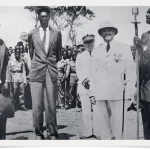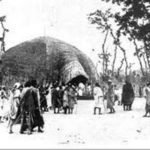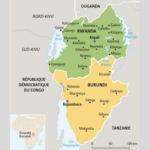Mutara Semugeshi and Mibambwe Gisanura: Innovative Kings or Imaginary Kings?
Such questions can be extended. Many of the uncertainties in the traditions attributable to Nyamuheshera appear also in the traditions of his immediate predecessor and successor. To Mutara Semugeshi are attributed few historical traditions, over a reign that Kagame estimates at the standard thirty-three years.The great bulk of the traditions on Semugeshi are limited to the attribution of cultural features introduced during his reign. While ethnographic data are valuable for historical analysis, questions arise on the validity of attributing the introduction of complex phenomena to a single moment of time by a single person. Oral sources frequently telescope complex processes, associating their invention with a single individual. Therefore, the presence of any given cultural element can hardly be used as proof of the historicity of any given king. In addition, we have already mentioned that the sons of Nzuki, said to be himself the son of Mutara Semugeshi and the grandson of Ruganzu, are called the Abaganzu; they are said to count six to eight generations from Nzuki to 1950.
By far the most significant event that Kagame attributed to the reign of Semugeshi was the introduction of the position of “king of the Immandwa” to the royal court of Rwanda.One of the reasons that Kagame attributes this event to Mutara Semugeshi is that his reign followed that of Ruganzu, who is associated with the first arrival of Ryangombe into the country.In addition, the names of the first officeholders of this position are not known, despite its importance for Rwandan ritual and despite the political influence wielded by any individual designated as head of the initiates to the cult: “Le nouveau dignitaire, comme bien l’on pense, devint brusquement un gros personnage, grace à son autorité morale sur tous les initiés du pays. Nous ignorons cependant, les tout premiers titulaires de cette dignité.”
A similar absence of data is apparent for the reign of Mibambwe Sekarongoro Gisanura (reign twelve back from 1959), given as the successor to Nyamuheshera. From the fact that during his reign a certain Rwambali is said to have died as liberator-hero in a war against Gisaka, Kagame deduces that Gisanura fought a war against Gisaka.But Delmas cites Rwambali as about nine generations back from 1950 (with a spread among different sources of seven to eleven generations); the Rwandan king list includes twelve reigns over that span.In addition, Kagame uses Poem No. 49 as a source to establish the historicity of Gisanura, but he tells us too that the poem was composed under Cyilima Rujugira, a much later ruler (and one who ruled at a time of the elaboration of court culture). If this is the case, Kagame’s conclusion is not based on contemporary evidence, only reinforcing the suspicion of an ex post facto assertion of Gisanura as king.
Because some of the most complete royal traditions deal with army organi-zations for each of the kings, it might be useful to summarize the information on relevant armies cited in Kagame’s Les milices, a valuable collection of official army histories for the kingdom of Rwanda.Of the armies of Ruganzu, we have already noted the case of the Ibisumizi, of which Semugeshi was a member. After Ruganzu, this army is not heard of again in the sources until the reign of Rujugira. The son and successor of the army leader at the time of Rujugira died during the reign of Rwogera, it is said. For the Abaruhije, another army recruited under Ruganzu, there are no data appearing under the three successors to Ruganzu: Semugeshi, Nyaruheshera, and Gisanura. For Nyakara, a third army formed under Ruganzu, there is no subsequent mention until the time of Rujugira, when it was led by a certain Nkoko. Bashana, the son of Nkoko (seven generations from 1950) was killed under Gahindiro (early nineteenth century), as was the grand-son of Bashana.The same pattern holds for the Nyantango, a fourth army formed under Ruganzu: no subsequent leaders are known until the time of Rujugira—despite the many campaigns said to have been undertaken by Nyamuheshera in other sources.
The armies of Semugeshi (the Abaganda) and Nyamuheshera have been mentioned above. It need only be remarked here that it is characteristic of the sources on all these armies that no details are retained before Cyilima Rujugira; from the time of his reign (or occasionally from the reign of Gahindiro three reigns later), all army leaders are traced precisely reign by reign. Of the five armies cited for Mibambwe Gisanura, four were, in Kagame’s own words, “insignificant.” (Two of them, in fact, were not truly milices but local neighborhood units to which a chief was assigned.) For none of them does a chief list go back beyond Gahindiro with the exception of one, which in turn is portrayed by Kagame as simply a land fief. The chief list for this group includes twelve names (generations and royal tie-ins are not given), to Mibambwe Gisanura (who is also twelve royal generations back from 1960).
In many cases, therefore, in a consistent pattern the traditions of institutions associated to the kingship omit reference to the four kings who follow Ruganzu in Kagame’s king list, and pick up again only with Rujugira or Gahindiro. For the first three successors to Ruganzu, there is room to wonder if the men now called “kings” were not in fact army leaders of some kind; in the fourth case,if he wasn’t a judge or other royal counselor. In other words, the entire cycle of kings to follow Ruganzu seems suspect; given the predilection for the integrity of dynastic cycles, it is likely that the entire cycle has been elaborated, along the lines of what appears to have been the case for the Burundi chronology. Ques-tioning the integrity of the entire cycle after Ruganzu, of course, would force a significant revision of the official chronology of the kingdom. But the same analytic calculus can be applied to the reign of Ndabarasa—the successor to Rujugira on the official king list and (like Nyamuheshera) another dynastic “Kigeri”—for data on his reign are equally scanty and suggest that Ndabarasa was a military hero (especially prominent for his wars in Ndorwa) only later ascribed royal status, with a twenty- to thirty-year reign, according to the diverse royal chronologies. (Even were he enthroned as king, it is plausible that the reign length attributed to him was extended to include both his career as military leader and as royal sovereign.) Such revision suggests that the period of Rwaaka /Rujugira occurred in the second half of the eighteenth century, and that Ruganzu’s reign was closer to the mid-eighteenth century—a significant condensation of the official royal chronology (Kagame places Ruganzu at 1510–43).
I am not arguing that all the names in the “suspect cycle” are simple historical fabrications. Oral testimony does not often invent items out of thin air; instead it reclassifies—and reinterprets—historical actors. Indeed, it is entirely possible that some were kings, who perhaps had only short reigns, not the standard thirty-three-year reign assigned to them in the formalized king list. However, it is also possible that they (or some among them) were not legitimate kings at all, but functionaries associated with the institution of kingship who, over time, have come to be accepted as having royal status. At any rate, the indications are that as presented in the official histories, the chronological depth ascribed to the royal genealogy before Rujugira is suspect, and this opens questions as to other aspects of the king list, a list that, as we have seen, has been widely used to provide the chronological foundation for the region as a whole.
Collectively, these data suggest that a period of turmoil followed the reign of Ruganzu in the interval leading up to Rujugira’s accession. In fact, both Vansina and Rennie argue that effective power was held for many years before Rujugira by his brother Rwaaka; indeed, the official accounts acknowledge his “rule,” if not his “reign.” Yet Rwaaka has been expunged from the official chronicle. Two reasons (and they could be the same) are advanced for this: it is said he was not properly invested as king according to the requisite rituals, and dynastic ideology proscribes two rulers in any given generation.76 Regardless of the specific details, however, the fact remains that this period was one of considerable irregularities; out of this complexity the concept of kingship came to have much tighter ritual codification and ideological consistency. Under Rujugira, for example, the Ryangombe religious authorities—hitherto outside the purview of the court, perhaps in outright opposition to it—were brought under court control; army organization was given greater coherence, including the extension of army units to include Hutu formations; the corporation of ritualists was reorganized; royal traditions on army histories were reinforced and standardized; tribute forms were extended to new segments of the population; the ideology of family genealogies was established; and the poetic forms praising the king and court were elaborated and systematized.
The absence of firm data from earlier periods, of course, does not prove that the cycle before Rujugira did not exist, or even that it existed in diminished stature; it is, after all, no easy task to prove a negative. Nonetheless, it is suggestive, for many other elements from Rwandan sources support such a revision of the royal chronology. Furthermore, such internal indications need be seen in the context of the clear elaborations of multiple royal chronicles outside Rwanda, as explored earlier. And between the internal indications and the independent external data there is a clear convergence.
It is fair to ask, however, if we are not ignoring internal development within these institutions. It might well be that in criticizing the traditions in this man-ner, we are postulating the presence of a static state as in the time of Rwabugiri by assuming that armies always had a standing organization headed by a recognized leader delegated by the king. When we find no cattle army associated with the milices until after Rwogera, for example, might this not be associated with the institutional developments taking place at the time? To be too rigid in our demands on traditions is to ignore the characteristic of traditions, which obviously retain more and become fuller and more complete as the temporal distance from the present narrows. It is also to ignore the very historical development we seek, and which might exist right before our very eyes. Nonetheless, three facts militate against such a simple dismissal of this inquiry. First, the pattern set out here is consistent and suggestive: there is very little evidence to assert the historicity of the kings in the cycle between Ruganzu and Rujugira on the official king list. Second, there do exist data of much superior quality from previous reigns, so the difference cannot be attributed to temporal distance alone. And finally, the external data from neighboring slates—independent data, both from each other and from Rwanda (at least until the recent interventions traced out above)—converge to raise the specter of “systematic doubt.”
To be sure, the critique of oral sources alone is not equivalent to writing his-tory. Nonetheless, before we can rely on such sources for historical reconstruction with any confidence, we must be clear on the type of sources we are dealing with. The remarkable characteristic here is that traditions from outside the Rwandan dynastic arena have always been dismissed because they did not con-form to the official Rwandan traditions. As we have seen, one by one each was invalidated and reconstructed, until only the Rwandan chronology remained. Yet when looked at as a whole, it is clear that those sources—even those independent of one another—all concur: the Rwandan line as reported is longer than the others. There is no necessary reason why the Rwandan line should be considered as more valid than the others, especially when, collectively and independently, all others point in the same direction.
This essay has not tried to reconstruct the royal history even at this schematic level. But it has pointed to certain parameters in the process of understanding Rwandan history, even if that understanding leads to agnosticism rather than certainty. It questions our faith in those elements formerly taken as essential to historical understanding and as capable of exactitude: the Rwandan dynastic chronology is certainly not the latter, capable of exactitude; and perhaps it is not quite the former, the essential characteristic of history. Precisely because such inquiry cannot respond to these concerns, it forces us to look to other forms of conceiving history. Pursuing such questions still opens up valuable insights, not of historical “fact”but of historical process. If in some fields of study the message is the medium, in this field the essential fact is in the formulation of the concept of fact; the meaning of the fact is in its imagining. For many people in this area, the fantasy of the Rwandan chronology may have become part of their own historical reality.
https://uk.amateka.net/mutara-semugeshi-and-mibambwe-gisanura-innovative-kings-or-imaginary-kings/https://uk.amateka.net/wp-content/uploads/2024/11/semugeshi.pnghttps://uk.amateka.net/wp-content/uploads/2024/11/semugeshi-150x150.pngHistory of kingsSocial & cultureSuch questions can be extended. Many of the uncertainties in the traditions attributable to Nyamuheshera appear also in the traditions of his immediate predecessor and successor. To Mutara Semugeshi are attributed few historical traditions, over a reign that Kagame estimates at the standard thirty-three years.The great bulk of the...BarataBarata rpierre@ikaze.netAdministratorAMATEKA | HISTORY OF RWANDA



